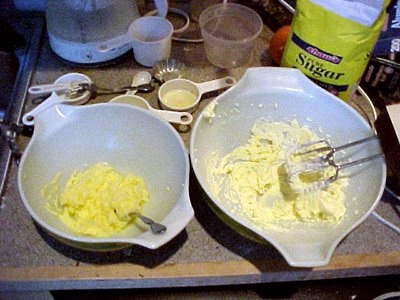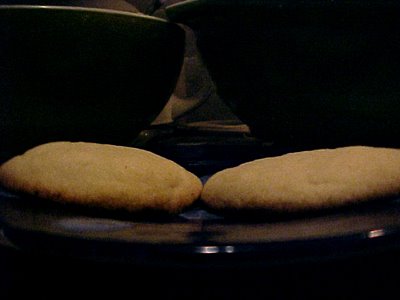Summary o' Conclusions: The electric mixer seems the best method in theory, but experiments show no difference between a cookie made with a mixer and one made by hand. Further experiments are needed.
Introduction:
I always use an electric mixer to thoroughly cream the butter or margarine before using it. I then use the mixer to thoroughly cream the sugar into the butter, then the eggs (one at a time), then the vanilla.
The reasoning behind this is sound: butter from the refrigerator is dense and hard. Even after softening, it's too cold and hard to combine with the other ingredients. Creaming with an electric mixer makes it smooth, aerated, and ready for action.
I've read that beating the butter by hand is acceptable, but results in a cookie that's a little flat, since not enough air was whipped into the butter. My own experiments with this, though, have yielded ambivalent results.
The Experiment:
Here is the same cookie recipe. On the left, I beat everything together using a fork but didn't "cream" it. On the right, I cream the butter and everything else using an electric mixer.
The start.

Added sugar and eggs.

Close up, you can see how different their textures are. The creamed butter is whipped up into an aerated, light dough, while the hand beaten dough is thicker and heavier.


Once the flour is added, though, the textures appear almost identical.
A note on my baking technique:
I tried to control all the variables here that I could. I divided a cookie sheet in half, and cooked one half of it with mixer-mixed dough and one half with hand-mixed. The first batch, I baked with the mixer-mixed dough closer to the oven dough, and on the second batch, I baked with the hand-mixed closer. I chilled the pan before each batch. I wanted each bit of dough to be treated equally in every respect – except for mixing method.
The Results:

 On the left, the hand-mixed cookie. On the right, the mixer-mixed cookie.
On the left, the hand-mixed cookie. On the right, the mixer-mixed cookie.The cookies are almost identical. The hand-mixed ones are slightly more puffy than those mixed with an electric mixer. It's possible that the electric mixer warmed the butter more than hand mixing did, allowing the cookies to spread more before solidifying.
They tasted the same – light, puffy, and wonderful.
Conclusion:
Though the dough was obviously much lighter, fluffier, and more aerated when beat with an electric mixer than when beat by hand, the resulting cookies appeared the same.
It is possible that this was just an exceptionally stable recipe, and that further experiments on other recipes will reveal differences. Or it's possible that the cookie is such a versatile confection that it doesn't notice differences that more sensitive pastries and cakes would react to.
I'll continue to use my electric mixer, but it's good to know that Disaster won't strike if I need to beat up a batch by hand.

No comments:
Post a Comment